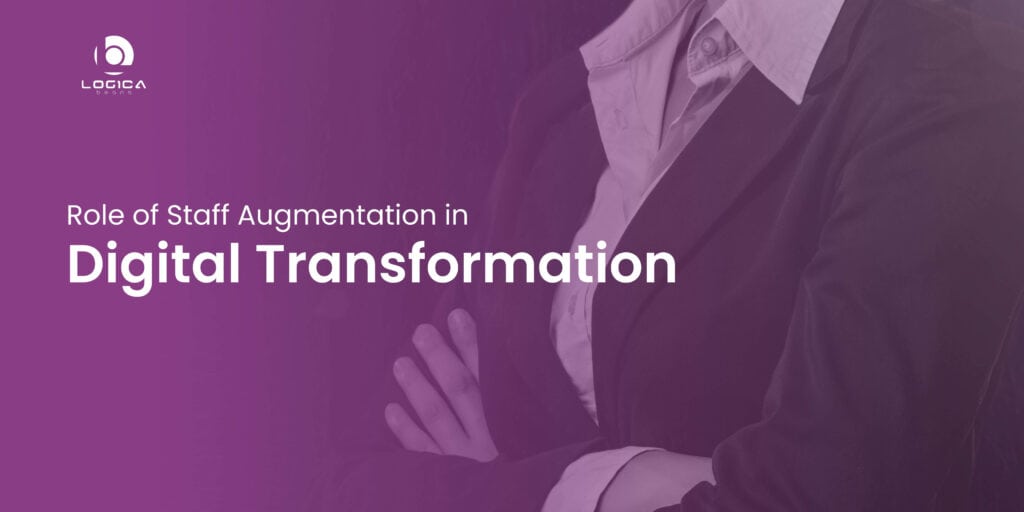As more businesses strive to stay up with the fast-paced technology improvements, digital transformation has become a term in the business world. Yet, executing digital transformation is a difficult process that needs tremendous time and money. Finding the necessary personnel to execute digital transformation efforts is one of the most difficult difficulties that businesses confront.
Businesses are continuously looking for new and inventive methods to alter their operations and stay ahead of the curve in today’s fast-paced digital world. Having the proper personnel in place to drive change and innovation is a critical component of any successful digital transformation plan.
Staff augmentation is a strong tool that can help firms tap into a range of experience and resources to fulfil their digital transformation goals. However, what exactly is staff augmentation in digital transformation, and how can it assist organizations in thriving in today’s competitive digital landscape?
Join us as we delve into the fascinating world of staff augmentation in digital transformation and its important role in advancing digital transformation.
Overview on staff augmentation
Staff augmentation is a business approach that entails acquiring additional expertise or teams to enhance existing workers. This method enables firms to swiftly and efficiently increase their workforce, acquire specialized talent, address gaps in experience and resources, and stay flexible and adaptive in the face of changing business demands.
Staff augmentation is frequently utilized in the context of digital transformation, when firms demand highly particular skills and expertise to remain ahead of developing technologies and trends. When compared to typical recruiting techniques, staff augmentation offers organization’s a more cost-effective, scalable, and flexible answer to their employment demands.
Staff augmentation is a growing business technique that has gained popularity in recent years. Staff augmentation is the practice of hiring additional expertise or teams to supplement the existing workforce. This is especially useful when organizations lack internal knowledge or need to rapidly increase their staff for specific tasks.
In several aspects, staff augmentation varies from standard recruiting practices. For starters, it allows firms to access specialized skills without the long-term commitment and price of recruiting full-time staff. Businesses can hire external specialists on a project or for a certain length of time rather than paying the expenditures of employee benefits, training, and overhead.
Staff augmentation enables firms to increase their personnel rapidly and efficiently. This is especially useful in the context of digital transformation, where firms must keep up with evolving technology and trends. Businesses can address gaps in expertise and resources as needed by using external expertise, rather than being constrained by internal people and resources.
Staff augmentation is a different recruiting strategy than standard hiring methods in various aspects. Here’s a more in-depth discussion of the distinctions:
● Timeframe
Rather than recruiting full-time workers, staff augmentation often includes engaging external specialists or teams for a certain project or length of time. Conventional recruiting practices, on the other hand, entail employing full-time staff who are expected to stay with the firm indefinitely. Staff augmentation allows organizations to be flexible in terms of engagement time, allowing them to increase their staff swiftly for unique needs.
● Cost
Staff augmentation in digital transformation can be a cost-effective choice for organizations since it allows them to access highly specialized skills without incurring the long-term costs of recruiting full-time personnel. Businesses that use staff augmentation pay just for the services they demand, rather than the continuous expenditures of employee benefits, training, and overhead. Traditional recruiting techniques, on the other hand, might be more expensive in the long term since firms must shoulder the expense of acquiring, training, and keeping full-time staff.
● Expertise
Staff augmentation provides firms with access to a broader spectrum of specialized experience than they could have in-house. This is especially useful in the fast-paced world of digital transformation, where firms must keep up with developing technology and trends. Businesses can obtain a competitive advantage and achieve their business goals more efficiently and effectively by engaging external specialists with highly specialized skills and expertise. In contrast, traditional recruiting processes can confine firms to a smaller variety of knowledge.
● Scalability
Staff augmentation enables firms to increase their staff rapidly and effectively in response to changing business demands. Rather than being constrained by internal resources and experience, organizations can draw on a pool of external talent to cover skill and resource shortages as needed. This is especially useful during times of development or change, when firms must swiftly scale up to meet demand. Conventional recruiting practices can be slower and less adaptable to changing corporate requirements.
● Flexibility
Employee augmentation allows firms to be more flexible with their engagement models. Businesses, for example, might recruit external expertise on a project basis, for a certain length of time, or as a long-term extension of their own workforce. This enables firms to stay flexible in the face of changing business demands and to select the engagement model that best meets their unique needs. Conventional hiring approaches, on the other hand, can be less adaptable and necessitate a more inflexible organizational structure.
Digital transformation and its impact on staffing needs
The process of adopting digital technology to radically change how firms function and give value to consumers is known as digital transformation. Businesses’ employment requirements can alter in a variety of ways when they undergo digital transformation:
● New skills set
Since digital transformation necessitates the use of new technologies and platforms, personnel must be able to operate with these tools. For example, data analytics is an important part of digital transformation since it allows firms to gather and analyze massive volumes of data to make educated decisions. Unfortunately, many traditional employees lack the necessary abilities for data analytics. As a result, businesses can need to engage outside specialists or teams to enhance their current staff with specific skill sets.
● Increased demand for tech talent
Digital transformation necessitates the use of new technologies and platforms, which necessitate the implementation and management of qualified individuals. Companies, however, can find it difficult to attract and keep qualified personnel as the demand for digital skills grows. Cloud computing, for example, is a vital technology in digital transformation, and it necessitates experts in cloud computing platforms such as Amazon Web Services (AWS) and Microsoft Azure.
● Faster pace of change
The pace of change in corporate operations and consumer expectations has been accelerated by digital transformation. Businesses must adjust swiftly to these developments, which can need a more flexible workforce. Staff augmentation enables firms to swiftly scale up or down their personnel to suit changing demands. Companies, for example, can need to hire more people during a product launch or peak season, and then cut their workforce when demand falls. Staff augmentation enables firms to get the expertise they require to address these short-term demands without incurring the administrative costs and long-term commitments associated with traditional employment.
● Emphasis on innovation
Businesses must innovate and explore new methods of doing things as part of their digital transformation. Businesses need to engage outside specialists or teams to help drive this innovation and give fresh insights on existing processes and systems. Staff augmentation can enable access to expertise in specialized areas of innovation, such as blockchain, augmented reality, or virtual reality. This expertise can work alongside current teams to help drive innovation, without the expense and long-term commitments of traditional recruiting.
● Outsourcing non-core functions
Businesses have the option to outsource non-essential operations to external specialists or teams while they focus on their core strengths and digital transformation projects. Companies, for example, can outsource accounting or human resources tasks to third-party vendors. Staff augmentation allows firms to obtain these services at a low cost without incurring the continuous expenditure of full-time personnel. This strategy enables businesses to focus on their core capabilities and digital transformation activities while ensuring non-essential operations are handled effectively.
Digital transformation necessitates that organizations be nimble, inventive, and laser-focused on their core capabilities. Staff augmentation allows firms to obtain specialized skills, swiftly increase their personnel, and outsource non-core services in a flexible and cost-effective manner. Businesses can stay competitive in a fast-changing digital market by using workforce augmentation.
Challenges faced by staff augmentation in digital transformation
Staff augmentation refers to the practice of hiring external resources to supplement an organization’s existing workforce. In the context of digital transformation, staff augmentation involves hiring technology experts, developers, and other IT professionals to accelerate the implementation of digital initiatives. However, staff augmentation in digital transformation is not without its challenges, which include:
● Skills gap: It might be challenging to find trained and experienced individuals with the precise skills required for digital transformation. This is especially true in new fields like artificial intelligence, machine learning, and cybersecurity.
● Integration: Staff augmentation can result in a mismatch between external personnel’s skills and knowledge and the demands of an organization’s current staff. This can make integrating external personnel with the existing team and procedures difficult.
● Cost: Staff augmentation can be costly, especially when there is a significant demand for technical professionals. This can put a burden on finances and make efficient resource allocation challenging for businesses.
● Communication: Communication can be difficult when dealing with external resources, especially if they are in different time zones or nations. Miscommunications can cause delays, mistakes, and misunderstandings, all of which can have an influence on project outcomes.
● Cultural fit: External resources can be unfamiliar with an organization’s culture or style of functioning, which can result in a lack of alignment and disputes.
● Security: External resources brought into an organization’s IT infrastructure might present security issues if suitable security rules are not followed. This can jeopardies critical data and harm one’s reputation.
Organizations can alleviate these issues by establishing clear communication lines, providing precise project briefings, conducting in-depth interviews, and prioritizing the integration of external employees into the current team. It’s also critical to set clear expectations for deliverables, timetables, and money. Lastly, to reduce security threats, firms should guarantee that external resources follow the same security rules as internal personnel.
Role of staff augmentation in digital transformation
Digital transformation can be a complicated and difficult process that needs specialized people with knowledge in artificial intelligence, machine learning, data analytics, cybersecurity, and cloud computing. Staff augmentation can help firms manage personnel difficulties in digital transformation by providing them with timely and cost-effective access to specialized expertise. Here are some ways that staff augmentation can help with digital transformation staffing challenges:
● Fill skill gaps
Specialized personnel with experience in developing fields like artificial intelligence, machine learning, and data analytics are frequently required for digital transformation. These abilities might be tough to obtain in-house, particularly for firms just beginning their digital transformation journey. Staff augmentation enables firms to swiftly bridge skill shortages by offering access to specialized people with the skills required to speed digital initiative execution.
● Increase agility
Digital transformation initiatives can be complicated and unexpected, necessitating rapid scaling up or down as project requirements change. Employing full-time workers can be costly and time-consuming, particularly for short-term initiatives. Staff augmentation enables firms to add or remove expertise as required without incurring the extra expenses associated with full-time hiring. This can assist firms in increasing their agility and responsiveness, both of which are crucial in today’s fast-paced corporate climate.
● Reduce cost
Employing full-time personnel can be costly, especially when it comes to specialized individuals with knowledge in emerging fields like artificial intelligence, machine learning, and data analytics. Staff augmentation enables firms to have access to specialized expertise without incurring the extra expenses associated with full-time employee hire. This can assist firms in lowering expenses and allocating resources more effectively.
● Improve quality
Specialized personnel with domain expertise and experience are required for digital transformation initiatives, which can be difficult to source in-house. Staff augmentation in digital transformation allows organizations to have access to specialized personnel with the knowledge and experience required to guarantee that digital initiatives are implemented properly and quickly. This can lead to higher quality, lower risk, and enhanced customer satisfaction.
● Enhance innovation
Organizations must think outside the box to discover new and inventive solutions to business difficulties as part of their digital transformation. Staff augmentation in digital transformation gives firms access to specialists with various views and new ideas, which can assist them in developing new and inventive solutions to business difficulties. This can lead to enhanced competitiveness, market share gains, and revenue growth.
Best practices for implementing staff augmentation in digital transformation
Implementing staff augmentation in digital transformation can be a complex process, and there are certain best practices that organizations can follow to ensure success. Here are some best practices for implementing staff augmentation in digital transformation:
● Define project scope and requirement
It is critical to specify the project scope and needs before employing staff augmentation in digital transformation. This will aid in identifying the skills and expertise required to meet project objectives, which can subsequently be utilized to establish the sort of talent required for staff augmentation in digital transformation. Properly outlining project scope and criteria will aid in bringing on the right people and meeting project goals on schedule and within budget.
● Select the right staffing partner
Selecting the correct staffing partner is important to the success of digital transformation workforce augmentation. The staffing partner should be well-versed in digital transformation and emerging technologies, as well as having a track record of offering high-quality employees. A robust verification procedure should also be in place to guarantee that the personnel given has the requisite skills and expertise to satisfy project objectives.
● Establish clear communication
Effective communication is critical for the success of digital transformation workforce augmentation. The staffing partner and the company should collaborate closely to develop clear communication channels, such as weekly status reports and regular check-ins. This will assist to keep the project on track and resolve any difficulties or concerns as soon as possible.
● Provide adequate support and resource
Staff augmentation in digital transformation can be a difficult process, and proper support and resources are required to assure success. This entails supplying the essential tools and resources, such as access to technological platforms and data, as well as fostering a positive work atmosphere. It is also critical to give clear advice and direction, as well as to define roles and duties.
● Measure and track performance
Monitoring and tracking performance is crucial for the success of digital transformation workforce augmentation. Tracking key performance indicators (KPIs) such as project milestones, productivity, and quality is part of this. This will aid in identifying areas for improvement and ensuring that the project remains on schedule and fulfils project objectives.
● Foster a collaborative work culture
Creating a collaborative work culture is crucial for the success of staff augmentation in digital transformation. Establishing a team-oriented work atmosphere and encouraging open communication and collaboration among team members are examples of this. This will help to keep the project on schedule and team members working successfully together to achieve project goals.
Staff augmentation in digital transformation necessitates careful planning, clear communication, and a collaborative work culture. Organizations can assure the success of staff augmentation in digital transformation and the effective and efficient implementation of digital transformation initiatives by following these best practices.
Conclusion
If you are contemplating staff augmentation in digital transformation, you must first evaluate your unique digital transformation objectives and goals. Begin by identifying the areas in which you require more experience and talents, and then determining the amount of assistance necessary. Staff augmentation in digital transformation can be an efficient approach to fill gaps in your current staff by gaining access to specialized skills and expertise without having to hire full-time personnel. Yet, it is critical to thoroughly consider your alternatives and select a partner that can provide high-quality skills and assistance.










